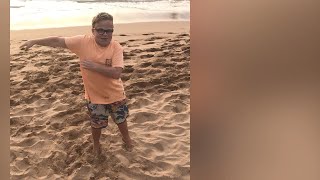Victor Harten’s perfect towheaded baby boy, Henry, was little more than a year old when a Seattle neurologist diagnosed him with Hurler syndrome, a rare genetic disorder characterized by an enzyme deficiency that allows large sugar molecules to build up in all the tissues of the body, causing catastrophic damage and, if untreated, early death.
“After crying for a week, I got on the phone and learned we could arrest his disease with a stem cell transplant,” Victor says. Henry underwent the stem cell transplant — a nine-month process. Afterward, Victor and Henry moved back to Victor’s home state of Texas to be near family.
Henry, now 21 years old, is the spunky veteran of some 40 surgeries to correct the damage to his joints and spine wrought by Hurler’s during his first year of life. But one of the things that bothered him most was yet another common symptom of the disease — cloudy corneas.
The cornea is the normally clear outer layer of the eye, and from the time Henry was a toddler, it was like looking through a fogged shower door with a coat of Vaseline on it,” Victor says. “And I couldn’t find anyone in Texas willing to treat him.” Indeed, the specialized care required to address not only Henry’s eye condition but the risks anesthesia posed to him because of Hurler syndrome was hard to come by. After six doctors turned him down, Victor wrote to the head of the National Institutes of Health, who promptly referred him to Albert Jun, M.D., Ph.D., the Walter J. Stark, M.D., Professor of Ophthalmology and chief of the Division of Cornea, Cataract and External Eye Diseases at the Wilmer Eye Institute.
What Jun could offer was a cutting-edge transplant procedure known as DALK, or deep anterior lamellar keratoplasty, to replace just the middle layer — the part that was damaged — of Henry’s cornea.
The cornea has three layers, and sparing Henry’s own bottom layer would mean he would be far less likely to reject the transplant or suffer other complications. It would also triple the life span of the transplant — meaning his new, improved cornea would likely last Henry a lifetime.
Jun is one of the world’s experts in performing the extremely delicate procedure, supported by a specialized and very expensive piece of equipment called an optical coherence tomography enabled/integrated surgical microscope. The entire cornea is minuscule, about two-hundredths of an inch thick. This state-of-the-art imaging machine — which allows Jun to see every layer, enlarged and distinct, on a big computer screen — minimizes the risk of damaging the bottom layer and, thus, the need to replace the entire cornea after all.
“I knew Dr. Jun was a perfectionist from our first appointment,” Victor says. “He had a team of physicians, and he would say, ‘Run that test again,’ over and over, until he was satisfied. I had complete confidence in him.”
But Jun sees the story of Henry’s treatment as “a true Hopkins story” because it wasn’t just his own surgical prowess that made it possible. Hurler’s patients are particularly challenging to operate on; even anesthetizing them can be life-threatening.
“Hurler’s patients have historically been considered the most difficult to put a breathing tube in,” says Nicholas Dalesio, M.D., M.P.H., associate professor of anesthesiology and critical care medicine, who participated in the surgery. Dalesio is also director of the Pediatric Difficult Airway Program at Johns Hopkins, an ultraspecialized program that encompasses an emergency response team, a difficult airway consultation service and a multidisciplinary program to educate clinicians on basic and difficult airway management.
Henry’s surgery was in January 2021, and Victor and Henry, who love to travel together, used it as an excuse for a road trip, driving all the way from Texas to Baltimore. “Henry got to see 12 states [and] learned a lot of geography,” Victor says.
Their surgical team at Wilmer was taking no chances. In talks he gives to doctors around the country, Dalesio emphasizes the importance of planning when intubating people with difficult airways. Jun says more than 20 people were involved in preparing for Henry’s surgery. A special team was assembled, everyone’s schedules coordinated and 1,000 pounds of equipment, including that expensive microscope, moved across the street to the main hospital, where additional specialized equipment and emergency care would be readily available.
Intubating patients usually takes about four minutes; intubating Henry took an hour, with the expert team working together to provide the specialized care he needed. “We had a lot of incredibly experienced people doing everything from administering drugs and grabbing equipment to adjusting Henry’s body,” says Dalesio. “You can’t work on someone as complex as Henry by yourself.”
Tina Tran, M.D., chief of anesthesiology for the Wilmer Eye Institute, who helped plan the surgery, says working as a team is key to delivering optimal care. “Knowing and respecting one another’s expertise is everything,” she says.
The surgery was successful, and Jun remembers marveling that morning about all the resources and preparation that had gone into one corneal transplant. (Jun estimates that he spent over 40 hours on the planning alone.) “My next thought was that this is exactly why we are here, so that someone like Henry, who can get the care he needs at only a handful of places in the world, can realize his dream of being able to see.”
Henry was delighted with the results of the surgery. It takes about a year to fully recover, but for the first time, he could see out of the eye that was operated on. “I couldn’t believe what things actually looked like,” he says.
While Henry is recovering from recent ankle surgery, he is already looking ahead. Victor says Henry, whose strong sense of faith has helped see him through turbulent times, would like to pursue an undergraduate degree in ministry. “Knowledge is power,” says Victor. Indeed.

